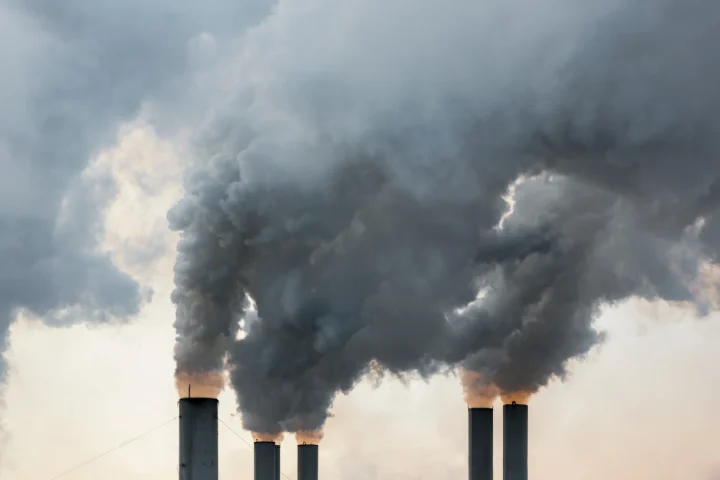Akindele Akinola, a livestock farmer in Omi-Ido area of Ibadan, Oyo state, has been feeding his family with the proceeds from his poultry business for the past three years. Recently, he was faced with a challenge that overwhelmed his years of experience.
Between January 22 to 26, Akinola lost 30 broilers in his farm owing to the stress from “too much heat”.
“On a particular day, the heat was too much and in the evening, we lost some of our chickens. After we lost them, we immediately knew that it was the stress from the heat that caused it,” he said.
The Nigerian Meteorological Agency (NiMet) had earlier in the year predicted a prolonged heat wave across the country. The agency said that air temperature in the north is at 41°C and 39°C over the south, indicating a significant increase in temperatures.
Advertisement
Vincent Weli, NiMet’s director of weather forecast services, highlighted the potential dangers of prolonged exposure to the extreme heat. He emphasised the need for immediate action, suggesting a state of emergency could help mitigate the risks.
Rising temperatures as a result of climate change have contributed to more frequent and intense heat waves in recent years.
These extreme weather events can cause heat-related illnesses and pose significant threats to not only human health but also livestock and crop production.
Advertisement
Consequently, farmers like Akinola, who are trying to earn a simple living, are left to deal with the loss of their livestock during the scorching weather.
WHAT IS HEATWAVE?

A heatwave is a prolonged period of excessive hot weather, typically with high temperatures and often accompanied by high humidity. Heatwaves can be dangerous and have various impacts on human and animal health, agriculture, and the environment.
Heatwaves can be caused by a variety of factors, including high-pressure systems, stagnant air masses, and the influence of climate patterns like El Niño.
Advertisement
When high-pressure systems linger over an area, they can trap warm air and prevent it from dissipating, leading to prolonged periods of hot weather. Stagnant air masses can also contribute to heat waves by preventing the movement of cooler air.
Heatwaves can have several long-term effects on the environment. They can lead to drought conditions, which can negatively impact agriculture and water resources. In addition, heat waves can cause damage to ecosystems, such as coral reefs and forests, leading to long-lasting impacts on biodiversity.
HEAT STRESS IN LIVESTOCK
Livestock, in particular, are highly susceptible to the adverse effects of heat stress during hot and humid weather conditions.
Advertisement
During this period, livestock face increased body temperatures due to the rise in environmental temperature and this can disrupt normal physiological processes and result in heat stress.
Birds are said to be heat stressed if they have difficulty achieving a balance between body heat production and body heat loss; this means there is a negative balance between the net amount of energy flowing from the birds to the environment and the energy it produces.
Advertisement
Heatwaves also increase the risk of heat-related illnesses in livestock, such as heat exhaustion and heatstroke. These conditions can lead to organ failure and even death.
Heat stress can negatively impact reproductive performance in livestock, resulting in decreased fertility rates, reduced conception rates, and increased embryonic mortality.
Advertisement
In addition, heat stress hinders growth rates and weight gain in livestock, affecting the profitability of meat and poultry production.
Akinola told TheCable that the kind of chickens in his farm do not have sweat glands and that they generate a lot of heat on their own.
Advertisement
“The heat around the environment becomes too high and there is no way for the chickens to naturally regulate it,” he said.
He noted that the heatwave “caused additional stress on the chickens and they were unable to maintain their normal temperature”.
Akinola said before the chickens started dying, he noticed that they were panting more, breathing faster and through their mouths.
He said their head cones turned a darker colour and their feathers were raised and stretched out, adding that they became weak and inactive.
After losing some chickens to the intense heat, Akinola said: “We isolated the weak ones, gave them extra space and fresh air, and made sure they had enough water.”
The farmer had to quickly come up with alternative ways to manage the situation and prevent more mortality.
“We used a knapsack sprayer to spray water on the chickens during the hottest time of the day. We were able to save the rest of the chickens, including the weak ones that were isolated. None of them died.”
HOW TO MANAGE HEAT STRESS IN LIVESTOCK

Several strategies can be implemented in managing heat stress in livestock.
Akinola said he was aware of the possible consequences of the heatwave and tried to take action to preserve the chickens “even though it was an extra cost for us”.
He said before the intense heat, the chickens were usually fed throughout the day but “when we noticed the situation, we stopped feeding them during the time of the day that is the hottest, around 11am to 4pm”.
“We provided extra and fresh water. We tried using fans to cool down the temperature of the environment,” he said.
“They didn’t have access to food but water during the hottest hours so that they won’t be consuming more and be stressing their system. We gave them water during that time and food during the night.
“We also made sure that there was cross ventilation and provided more free space for the chickens to move around. If the space could contain a thousand chickens, we reduced their numbers to 800 or 750 to allow for more space. We also added some electrolytes to their water to help cool down their body.”
Speaking on the matter, Nwachukwu Okechukwu, a veterinary doctor, said when the temperature is high, livestock farmers usually record high mortality rates.
Okechukwu said the hot weather affects not only the quantity of eggs produced but also the quality.
He highlighted some of the measures that farmers can adopt in managing heat stress and protecting their livestock during the heatwave.
“Farmers can sprinkle water on the birds, use supplements known as anti-stress to reduce the effects of the heat on the birds and add ice cubes to the water,” he said.
“Also, while erecting the building for poultry, the height of the building, the level of the blocks, and the spacing are all to be considered so that during the heatwave, the livestock won’t be really affected. It is wrong to have the poultry pen close to the fence. If the pen doesn’t have enough space and there is no ventilation, then the birds will be affected even more.”
To manage heat stress in livestock, experts say house design is also crucial and ensuring cross ventilation in the pens is important. It is beneficial to position the pens in an east-west direction to minimise exposure to direct sunlight. The roof should be high enough to allow for proper airflow because dwarf walls can release more heat. It is also essential to avoid overcrowding the birds in a pen.
Add a comment






